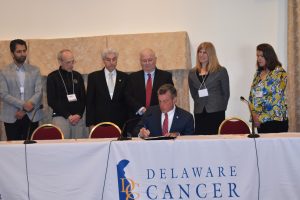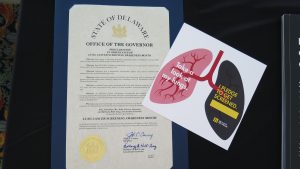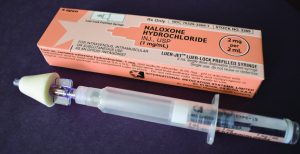DOVER (May 15, 2019) – During the 18th Prescription Drug Take-Back Day event on April 27, 2019, Delaware collected 5,385 pounds of unwanted or expired medicine, according to the U.S. Drug Enforcement Administration (DEA) and the Division of Public Health (DPH). That amount is approximately 1,600 pounds more than the 3,739 pounds collected in October. Since the first event in May 2010, Delaware has collected a total of 90,291 pounds of unwanted or expired medicine.
In addition to the 24 drop-off locations open to the public on April 27, there are also 21 permanent medication drop-off locations throughout the state. DPH officials say the increase in collections can be attributed to the cumulative efforts of the permanent drug collection sites, which turned in their medications collected over several months to the DEA on the day of the event.
“We appreciate all of the participants that take part in this biannual event, including not only the public, but also state and local law enforcement agencies,” said DPH Director Dr. Karyl Rattay. “Holding these events and giving residents a safe place to dispose of their prescription drugs will continue to decrease the risk of drug misuse and substance use disorder, as drug experimentation often begins at home. However we continue to encourage Delawareans to take advantage of the permanent prescription drug drop box locations and not feel that they have to wait for the next event to come around.”
According to the 2017 National Survey on Drug Use and Health, 6 million Americans misused controlled prescription drugs. The study shows that a majority of abused prescription drugs were obtained from family and friends, often from the home medicine cabinet. Since January 1, 2019, there have been 84 suspected overdose deaths in the state. In 2018, 400 Delawareans died from drug overdoses, according to the Delaware Division of Forensic Science.
DPH urges Delawareans to keep medications locked away and to drop them off at a permanent drug collection location when they are no longer wanted, necessary or have expired.
For recommendations on handling unwanted or expired prescription drugs, contact the DEA at 1-800-882-9539. If you were unable to participate in the April 27 event, you can still dispose of your prescription medication at one of Delaware’s 21 permanent drug disposal sites. View the list of sites at https://www.helpisherede.com/Get-Help/Prescription-Drug-Drop-Box.
The cumulative collections from the biannual Delaware Prescription Drug Take-Back Day events are:
May 14, 2010: 1,680 lbs.
September 25, 2010: 303 lbs.
April 30, 2011: 4,395 lbs.
October 29, 2011: 4,465 lbs.
April 28, 2012: 6,808 lbs.
September 29, 2012: 4,561 lbs.
April 27, 2013: 6,122 lbs.
October 26, 2013: 5,258 lbs.
April 26, 2014: 6,476 lbs.
September 27, 2014: 4,707 lbs.
September 12, 2015: 7,227 lbs.
April 30, 2016: 7,684 lbs.
October 22, 2016: 6,059 lbs.
April 29, 2017: 5,211 lbs.
October 28, 2017: 5,518 lbs.
April 28, 2018: 4,693 lbs.
October 27, 2018: 3,739 lbs.
April 27, 2019: 5,385 lbs.
A person who is deaf, hard-of-hearing, deaf-blind or speech-disabled can call the DPH phone number above by using TTY services. Dial 7-1-1 or 800-232-5460 to type your conversation to a relay operator, who reads your conversation to a hearing person at DPH. The relay operator types the hearing person’s spoken words back to the TTY user. To learn more about TTY availability in Delaware, visit http://delawarerelay.com.
The Department of Health and Social Services is committed to improving the quality of the lives of Delaware’s citizens by promoting health and well-being, fostering self-sufficiency, and protecting vulnerable populations. DPH, a division of DHSS, urges Delawareans to make healthier choices with the 5-2-1 Almost None campaign: eat 5 or more fruits and vegetables each day, have no more than 2 hours of recreational screen time each day (includes TV, computer, gaming), get 1 or more hours of physical activity each day, and drink almost no sugary beverages.


